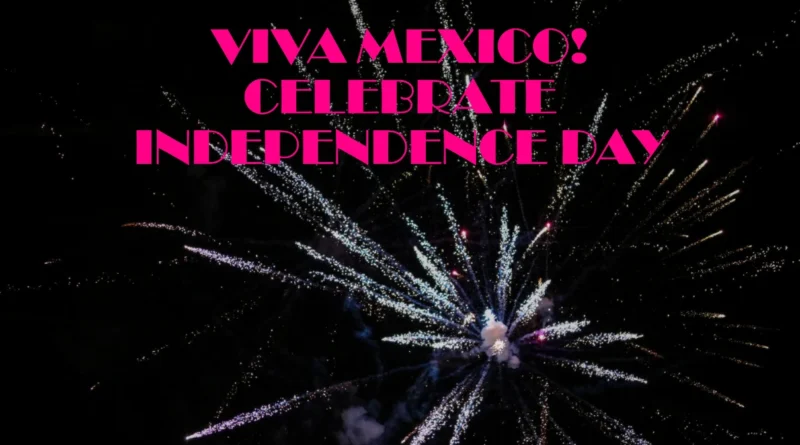Celebrating Mexican Independence Day: History, Traditions, and Festivities
Introduction
Mexican Independence Day, celebrated on September 16th, is a day of great historical significance and patriotic fervor for Mexico and Mexican communities around the world. This annual celebration commemorates Mexico’s declaration of independence from Spanish colonial rule and the culmination of a decade-long struggle for sovereignty. In this blog post, we will explore the rich history of Mexican Independence Day, its cultural and traditional significance, and how this important event is celebrated both in Mexico and abroad.
| Year | Event |
| 1810 | Father Miguel Hidalgo initiates the Grito de Dolores, sparking the war for independence. |
| 1821 | The Mexican War of Independence officially ends with the signing of the Plan of Iguala. |
| 1823 | Mexico becomes a federal republic. |
| 1862-1867 | French Intervention in Mexico. |
| 1910 | The Mexican Revolution begins, leading to major social and political reforms. |
| 1920 | The Mexican Constitution is adopted. |
| 1947 | September 16th becomes Mexican Independence Day. |
The Road to Independence
Background: Spanish Colonial Rule
To understand the significance of Mexican Independence Day, we must first delve into Mexico’s history under Spanish colonial rule. For nearly three centuries, Mexico, then known as New Spain, was under Spanish dominion. This period saw the exploitation of Mexican resources, forced labor, and social and economic inequality.
Hidalgo’s Call to Arms: The Grito de Dolores
The spark that ignited the Mexican War of Independence occurred on the night of September 15, 1810, in the small town of Dolores. Miguel Hidalgo y Costilla, a Catholic priest, issued the famous “Grito de Dolores,” a passionate call to arms against Spanish oppression. This event is now celebrated annually as the precursor to Mexican Independence Day.
The Mexican War of Independence
Following the Grito de Dolores, Mexico embarked on a tumultuous journey towards independence. Over the next decade, revolutionary leaders like José María Morelos and Agustín de Iturbide joined the fight for freedom. Finally, on September 27, 1821, the Spanish crown recognized Mexico’s independence, marking the end of the Mexican War of Independence.
The Significance of September 16th
Independence vs. Cinco de Mayo
It’s essential to distinguish between Mexican Independence Day and Cinco de Mayo, another widely celebrated Mexican holiday. While both events commemorate Mexican heritage and resilience, they have distinct historical origins. Mexican Independence Day marks Mexico’s independence from Spanish rule, while Cinco de Mayo commemorates the Mexican victory over the French at the Battle of Puebla in 1862.
“El Grito”: The Cry of Dolores
At the heart of Mexican Independence Day celebrations is the “El Grito” ceremony. On the night of September 15th, the president of Mexico, or local officials in various towns and cities, reenact Hidalgo’s historic call to arms. The crowd gathers in town squares, and at precisely 11 p.m., the “Grito” is recited, followed by shouts of “¡Viva México!” The atmosphere is electrifying, with fireworks, music, and dance performances.
Celebrations Across Mexico
| Tradition | Description |
| El Grito | The President of Mexico reenacts the “Grito de Dolores” on the night of September 15th. |
| Patriotic Parades | Colorful parades with marching bands and traditional costumes. |
| Fireworks | Elaborate firework displays light up the night sky. |
| Mexican Cuisine | Traditional dishes like chiles en nogada and pozole are enjoyed. |
| Music and Dance | Mariachi bands and folkloric dances are performed. |
| Decorations | Streets and buildings are decorated with the Mexican flag’s colors. |
Festive Atmosphere
Mexican Independence Day is characterized by a vibrant and festive atmosphere. Streets, buildings, and homes are adorned with Mexico’s national colors: green, white, and red. Decorative flags and banners featuring patriotic symbols such as the eagle and snake are proudly displayed. The sense of unity and pride is palpable.
Traditional Foods
No Mexican celebration is complete without traditional foods. Mexican families gather to enjoy a variety of dishes, including tamales, enchiladas, chiles en nogada (stuffed peppers in walnut sauce), and pozole (a hearty soup). Sweet treats like churros and pan dulce are also savored during the festivities.
Parades and Cultural Events
Across Mexico, parades and cultural events take place throughout the day on September 16th. These festivities showcase the diversity and richness of Mexican culture. Participants often wear traditional clothing, and there are performances of folk dances and music. Mariachi bands add to the festive spirit with their lively tunes.
Mexican Independence Day Abroad
| Celebration Location | Description |
| Mexico City | The country’s capital hosts a massive celebration in the Zócalo square. |
| Chicago, USA | One of the largest celebrations outside Mexico takes place in Chicago. |
| Cultural Festivals | Various cities around the world host cultural festivals to mark the day. |
| Community Gatherings | Mexican communities globally come together for festive events. |
| Online Celebrations | Due to the internet, people worldwide can participate in virtual celebrations. |
Diaspora Celebrations
Mexican Independence Day is not limited to Mexico; it is celebrated worldwide, particularly in countries with significant Mexican diaspora communities. Mexicans living abroad take this opportunity to connect with their roots, preserve their heritage, and share Mexican culture with others.
Prominence in the United States
In the United States, Mexican Independence Day has gained prominence over the years. Many cities with large Mexican populations, such as Los Angeles, Chicago, and New York, host grand parades, cultural events, and concerts. It has become a momentous occasion for Mexican-Americans to celebrate their identity and traditions.
Conclusion: A Celebration of Freedom and Heritage
Mexican Independence Day, rooted in the historical struggle for freedom, has evolved into a vibrant and spirited celebration of Mexican culture and heritage. Whether in the bustling streets of Mexico City, the plazas of U.S. cities, or Mexican communities worldwide, this day serves as a reminder of the enduring spirit of independence and the rich tapestry of Mexican identity. As the “Grito” echoes through the night, it reaffirms the unity and pride of a nation that cherishes its hard-fought freedom.




